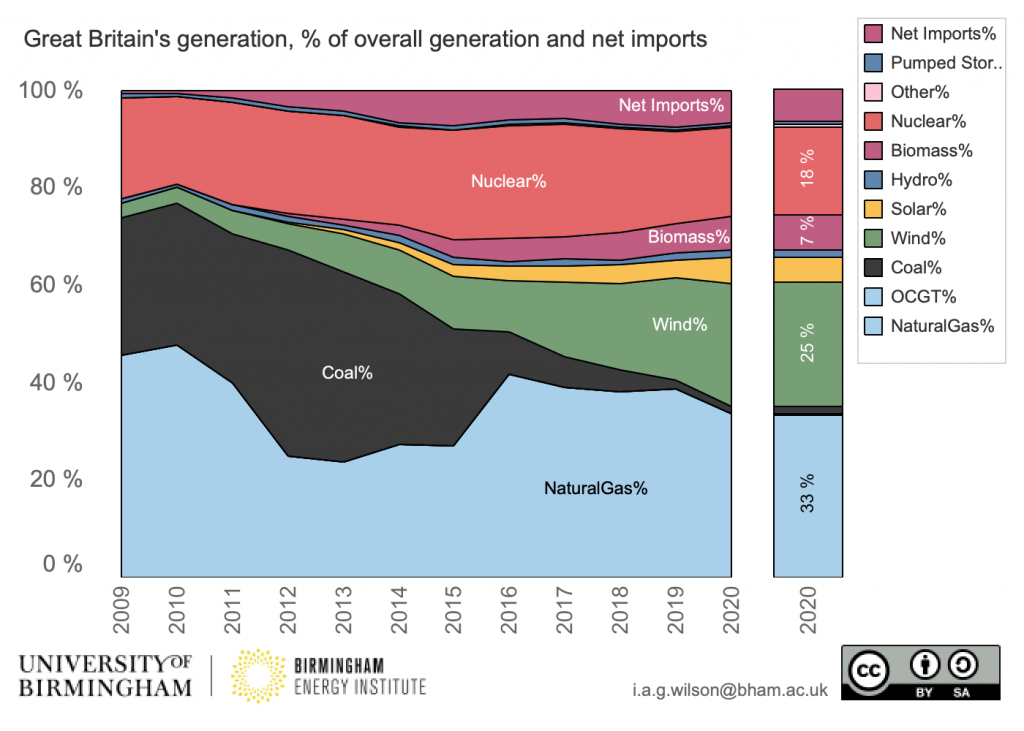As we transition to a more renewable energy mix, the need for low-carbon flexibility in our built environment is becoming increasingly important; could innovative thermal storage systems help accelerate this transition?
Although Great Britain has benefitted greatly from policies to decarbonise its electrical supply (Figure 1), the flexibility that underpins wider energy systems is fundamentally and overwhelmingly still based on fossil fuels.
For transport, buffers of liquid fuels along supply chains provide intrinsic storage to match the supply of fuels (mainly the harvesting of fossil fuels from the earth’s crust) to the demand for those fuels (the combustion of fuel in an internal combustion engine). For electric vehicles, the ability to store the ‘fuel’ helps energy systems to match supply from electrical generators and the demand on the battery from the vehicles’ electric motor(s) when driving. In a simple sense, it does not matter when a battery or fuel tank (for liquid fuels) are charged, just that it has a sufficient amount of energy to allow the user to undertake the end-user demand (using a vehicle to change location) when they wish to do so.

The same principle of having enough energy available when it is needed is similar for the built environment, with the biggest difference being that the end-user demand is typically geographically non-mobile. The timing of heating, cooling, hot-water provision or lighting can change, but the location of these end-user driven demand is tied to the building itself. However, the impacts of Covid-19 social distancing measures have shown that locational shifts of energy demand can also happen over short periods, e.g. from office space to domestic properties.
Similar to the transport sector, the built environment is also fundamentally and overwhelmingly still based on a fossil fuel (natural gas) to provide its energy flexibility, be that over an hourly, daily, weekly or seasonal basis. In 2020, fossil natural gas underpins the flexibility of the electrical system to be able to meet the swings in demand, driven to a large degree by the energy demand from users within buildings.

Figure 2 – Great Britain’s electrical generation for the month of August 2020. Total electrical demand is the red line, wind is green, solar is yellow and natural gas (Combined Cycle Gas Turbine) is blue.
When we also consider heating demand, within day and seasonal flexibility are also provided by natural gas, with major parts of the swing in demand being driven by space heating and hot-water demands, again, from users within buildings.
Therefore, Great Britain has a decarbonisation challenge that is based on three simple points:
- Fuels for buildings have to be decarbonised by 2050
- Flexibility in the existing system is currently provided by fossil fuels
- A major fraction of the need for flexibility is from users via the built environment
Work Package 3 of the Active Building Centre Research Programme is a collaboration between Loughborough University and the University of Birmingham to develop, test and deploy thermal storage technologies that help to provide low-carbon forms of energy flexibility within the built environment. Our belief is that the built environment provides a significant opportunity to supply flexibility, instead of historically just creating the demand for flexibility that would require to be satisfied elsewhere in the wider energy system. Buildings can play a positive supporting role to help accelerate decarbonisation, and thermal storage technologies are felt to be an important part of this.
Dr Grant Wilson of the University of Birmingham is contributing to thermal storage research activities in collaboration with Loughborough University as part of the Active Building Centre Research Programme.


